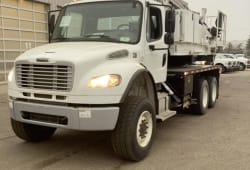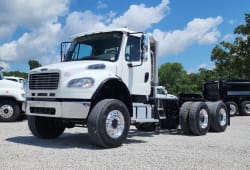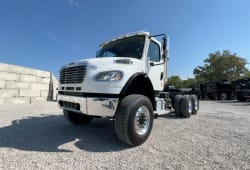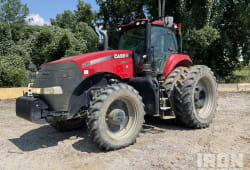JCB 531-70 vs. Manitou MT625: Which is best?
11 Lectura mínima
)
julio 19, 2023
When it comes to construction and agricultural machinery, the JCB 531-70 and Manitou MT625 are two popular choices that offer exceptional performance and reliability. In order to determine which of these telehandlers is best suited to your specific needs, it is important to understand their basic features and capabilities.
What is the JCB 531-70?
The JCB 531-70 is a versatile telehandler that is known for its exceptional lifting capacity and reach. Equipped with a robust engine, it delivers impressive power and performance. With a maximum lift height of 7 meters and a lift capacity of up to 3.1 tons, it can handle demanding lifting tasks with ease. Additionally, its compact size and agile maneuverability make it suitable for working in confined spaces.
One of the standout features of the JCB 531-70 is its advanced hydraulic system. This system allows for precise and smooth operation, ensuring that loads are lifted and placed with accuracy. Whether you're working on a construction site or a farm, this telehandler's hydraulic system will enhance your productivity and efficiency.
In addition to its impressive lifting capabilities, the JCB 531-70 also offers a comfortable and ergonomic operator's cab. Designed with the operator in mind, the cab provides excellent visibility and easy-to-use controls. This ensures that the operator can work for extended periods without experiencing fatigue or discomfort.
What is the Manitou MT625?
Similar to the JCB 531-70, the Manitou MT625 is a high-performing telehandler that excels in various applications. With a lift height of 5.85 meters and a lift capacity of 2.5 tons, it offers versatility and efficiency on the job site. The Manitou MT625 is equipped with advanced features and a reliable engine, ensuring optimal performance and productivity.
One notable feature of the Manitou MT625 is its innovative boom design. This design allows for increased stability and precision when lifting heavy loads. Whether you're lifting construction materials or agricultural products, this telehandler's boom design ensures that your loads are handled safely and securely.
In addition to its impressive lifting capabilities, the Manitou MT625 also offers excellent maneuverability. Its compact size and tight turning radius make it ideal for navigating through narrow spaces and crowded job sites. This means that you can easily maneuver the telehandler in tight spots without sacrificing performance or safety.
Both the JCB 531-70 and Manitou MT625 are exceptional telehandlers that offer a range of features and capabilities. Whether you choose the JCB 531-70 with its impressive lift height and compact size, or the Manitou MT625 with its innovative boom design and maneuverability, you can be confident that you're investing in a reliable and high-performing machine that will meet your needs on the job site.
Key Features Comparison
When comparing the JCB 531-70 and Manitou MT625, it is essential to examine their key features to determine their suitability for different tasks.
Engine and Power
The JCB 531-70 is powered by a robust engine that delivers ample power for lifting heavy loads. Its engine is specifically designed to provide exceptional torque and acceleration, ensuring efficient operation in demanding conditions. With its impressive power output, the JCB 531-70 can easily handle challenging tasks and maintain high productivity levels.
On the other hand, the Manitou MT625 is equipped with a reliable engine that provides sufficient power for various applications. The engine of the Manitou MT625 has been optimized to offer a balance between power and fuel efficiency, allowing for cost-effective operation without compromising performance. The Manitou MT625's engine has been proven to deliver consistent and reliable performance, making it a popular choice among users.
Both telehandlers have proven track records in terms of engine performance, ensuring that they can handle the demands of different job sites and applications.
Lift Capacity and Height
When it comes to lift capacity and height, the JCB 531-70 takes the lead with its impressive 3.1-ton lift capacity and 7-meter lift height. This exceptional lifting capability makes the JCB 531-70 ideal for handling heavy loads and reaching greater heights. Whether it's loading and unloading materials, stacking pallets, or working on construction projects, the JCB 531-70 can handle the most demanding lifting tasks with ease.
The Manitou MT625, with its 2.5-ton lift capacity and 5.85-meter lift height, offers slightly lower capabilities but is still suitable for a wide range of lifting tasks. The Manitou MT625's lift capacity and height make it a versatile telehandler that can handle various applications, such as landscaping, agriculture, and light construction projects. While it may not have the same lifting capacity as the JCB 531-70, the Manitou MT625 still provides sufficient power and reach for many common lifting tasks.
Size and Weight
In terms of size and weight, the JCB 531-70 is compact and lightweight, making it easier to maneuver in tight spaces and transport between job sites. Its compact design allows it to navigate through narrow passages and work in confined areas where larger machines may struggle. Additionally, the JCB 531-70's lightweight nature contributes to its excellent fuel efficiency, reducing operational costs and environmental impact.
On the other hand, the Manitou MT625 is slightly larger and heavier, but still offers good maneuverability and stability. Its size and weight provide added stability during lifting operations, ensuring safe and secure handling of loads. While it may not be as compact as the JCB 531-70, the Manitou MT625's size and weight make it suitable for a wide range of applications, including construction, agriculture, and industrial projects.
Both telehandlers have their advantages when it comes to size and weight, allowing users to choose the one that best suits their specific needs and working conditions.
Performance Analysis
When analyzing the performance of the JCB 531-70 and Manitou MT625 telehandlers, several factors come into play. Let's delve deeper into each aspect to gain a comprehensive understanding of their capabilities.
Terrain Handling
Both the JCB 531-70 and Manitou MT625 are designed to tackle various terrains, including rough and uneven surfaces. The JCB 531-70's advanced suspension system ensures a smooth and comfortable ride, even on the most challenging terrain. Its robust build and superior engineering allow it to effortlessly navigate through obstacles, making it an ideal choice for construction sites and agricultural fields.
Similarly, the Manitou MT625 boasts excellent traction and stability, enabling it to operate effectively in different conditions. Its well-designed chassis and powerful drivetrain work in perfect harmony to provide optimal performance, regardless of the terrain. Whether you're working on a construction site with loose gravel or an agricultural field with uneven ground, both telehandlers offer reliable and consistent performance.
Fuel Efficiency
When comparing telehandlers, fuel efficiency is a crucial aspect to consider. The JCB 531-70 incorporates advanced technology to optimize fuel consumption, resulting in lower operating costs and reduced environmental impact. Its intelligent engine management system ensures that fuel is utilized efficiently, allowing for prolonged operation without frequent refueling. This not only saves time but also contributes to a more sustainable and eco-friendly work environment.
Similarly, the Manitou MT625 is designed with fuel efficiency in mind. Its innovative engine and intelligent power management system work together to minimize fuel consumption, without compromising on performance. The telehandler's ability to operate for extended periods without the need for constant refueling makes it an excellent choice for projects that require long working hours.
Both the JCB 531-70 and Manitou MT625 prioritize cost-effectiveness and sustainability, ensuring that you get the most out of every drop of fuel.
Speed and Maneuverability
Fast and precise movement is essential in any telehandler. The JCB 531-70 offers impressive travel speeds, allowing for efficient material handling and enhanced productivity. Its powerful engine and advanced hydraulic system enable swift and smooth operations, making it an invaluable asset on the job site. Additionally, its excellent maneuverability allows it to navigate through narrow spaces with ease, ensuring that no corner is left untouched.
The Manitou MT625 also provides good speed and maneuverability, ensuring quick and efficient operation. Its agile design and responsive controls allow for seamless navigation, even in tight spaces. Whether you need to transport materials across a construction site or load/unload items in a confined area, the Manitou MT625 delivers exceptional performance.
Regardless of the task at hand, both the JCB 531-70 and Manitou MT625 excel in terms of speed and agility, enabling you to complete your projects efficiently and on time.
Safety Features
Safety is of utmost importance in any construction or agricultural setting. Both the JCB 531-70 and Manitou MT625 prioritize operator safety through various features.
When it comes to safety, the JCB 531-70 goes above and beyond. This telehandler is equipped with a comprehensive safety system that includes features like a Load Control System. This system not only prevents overloading but also ensures stability during operation. With the Load Control System, operators can have peace of mind knowing that they are working within safe limits.
Another safety feature of the JCB 531-70 is the Boom Forward Assist system. This system provides added visibility and safety by allowing the operator to adjust the position of the boom. By optimizing the boom's position, operators can have a clear line of sight, reducing the risk of accidents or collisions.
In addition to these features, the JCB 531-70 is also equipped with a ROPS/FOPS-certified cab. ROPS stands for Roll-Over Protective Structure, while FOPS stands for Falling Object Protective Structure. These certifications ensure that the cab is designed to protect the operator in case of accidents or rollovers. With the ROPS/FOPS-certified cab, operators can feel confident and secure while operating the JCB 531-70.
On the other hand, the Manitou MT625 also prioritizes safety with its impressive array of features. One of the standout safety features of this telehandler is the Load Management System. This system is designed to prevent tipping and maintain stability during material handling. By constantly monitoring the load and adjusting the machine's parameters, the Load Management System ensures that the telehandler remains safe and stable in any working condition.
Another safety feature of the Manitou MT625 is its anti-tilting system. This system further enhances safety during material handling by automatically adjusting the machine's stability parameters. By continuously monitoring the load and the telehandler's position, the anti-tilting system helps prevent accidents and maintain a safe working environment.
When it comes to operator comfort and safety, the Manitou MT625 does not disappoint. The telehandler is designed with a spacious and ergonomic cab that offers excellent visibility and comfort. With a clear view of the surroundings and a comfortable working environment, operators can focus on the task at hand without compromising their safety.
As you can see, safety is at the forefront of both the JCB 531-70 and Manitou MT625's designs. These telehandlers are equipped with a range of safety features that prioritize operator well-being and ensure a safe working environment. Whether it's the comprehensive safety system of the JCB 531-70 or the impressive Load Management System of the Manitou MT625, both telehandlers provide operators with the peace of mind they need to carry out their work efficiently and safely.
Cost and Value for Money
When considering the cost and value for money, it is essential to evaluate both the initial purchase price and ongoing maintenance and operating costs.
Initial Purchase Price
The JCB 531-70 tends to have a slightly higher initial purchase price compared to the Manitou MT625. However, it offers a range of advanced features and capabilities, making it a worthwhile investment for those requiring exceptional performance and versatility. The Manitou MT625 provides a more cost-effective option for those with more standard lifting requirements.
Maintenance and Operating Costs
In terms of maintenance and operating costs, both telehandlers are designed to minimize expenses and maximize productivity. With proper maintenance and servicing, the JCB 531-70 and Manitou MT625 are built to withstand demanding work environments and offer long-term reliability. Regular maintenance and adherence to the manufacturer's guidelines will contribute to reducing operational costs in the long run.
Conclusion
In conclusion, after a thorough comparison between the JCB 531-70 and Manitou MT625 telehandlers, it's evident that each model offers distinct advantages depending on the requirements of the task at hand.
The JCB 531-70 stands out with its exceptional lift capacity, height, and maneuverability, making it the top choice for heavy-duty lifting tasks in tight spaces. Its advanced features and robust design ensure reliable performance and efficiency, making it well-suited for demanding construction and agricultural projects.
On the other hand, the Manitou MT625 presents a more cost-effective option without compromising on performance and safety features. With its solid capabilities and innovative design, it offers a reliable solution for standard lifting requirements across various applications.
Ultimately, the best telehandler for your needs will depend on a combination of factors including the specific demands of your project, budget considerations, and desired features. Whether you prioritize maximum lifting capacity and maneuverability like the JCB 531-70 or seek a balance of performance and cost-effectiveness like the Manitou MT625, both models offer reliable solutions to enhance productivity and efficiency on the job site.

Samir Shah is the Co-Founder and Chief Product Officer of Boom & Bucket, where he leads the development of innovative solutions for buying and selling heavy equipment. With a background in engineering, product development, and business strategy, Samir has a track record of taking companies from concept to market success. Previously, he was the Head of Cat Digital Labs at Caterpillar, overseeing digital initiatives and product launches. He holds degrees from MIT Sloan and Carnegie Mellon, and he is passionate about tackling big challenges in underserved industries.














